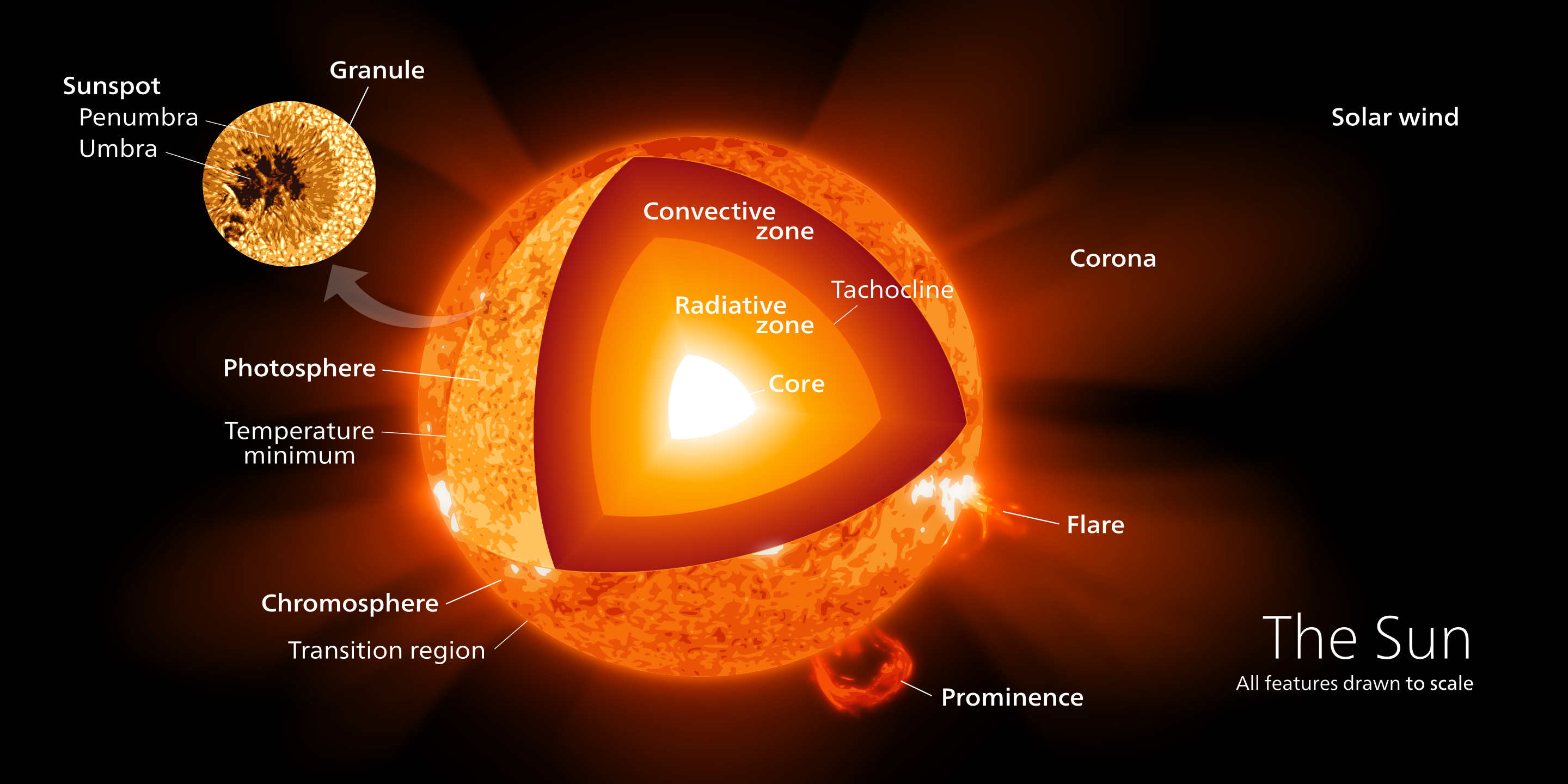DIS 01
Astronomical Distance:
1 AU(Astronomical Unit, the distance between sun and earth) = 1.5 x 10^8 km = 9.16 x 10^7 miles -> measure solor system
Lightyear(光年, which is a distance unit) = dist. light travels in 1 year = 9.45 x 10^12 km -> measure dist. between stars
parsec = 3.26 lightyears = 3.086 x 10^13 km -> measure galaxies+bigger
C = 3 x 10^5 km/s
c = lambda (wavelength) * v(frequency hz = 1/s)
E = hv = hc / lambda
DIS 04
- The sun is 1 AU
- M = 2 * 10 ^30 kg = 1 MO solar mass = 330,000 Earths
- Wien’s Law:

Layers of the sun:
- Core
- where the nuclear fusion (H -> He: 3.9 x 10^25 W per sec)
- very dense, T = 1.5 x 10^7 K
- Photosphere
- what we see -> emits light
- T = 5800 K
- lowenouth dens.
- Chromosphere
- low dens, T = 50,000 K
- Corona
- lowest des., T = 10^6 K
- see only during solar eciipses
Sunspots
- cooler regions on the photosphere caused by the magnetic field of the sun
- T = 4500 K
- can be larger than the size of the Earth
- As magnetic field gets twisted, it eventually breaks and release a ton of energy
- Solar cycle: every 11 years, number of sunspots peak at a maximum , then clearance again
DIS 05
Parallax, Luminosity and Brightness
- Distances to stars are found using parallax
- Apparent motion of an object due to changing viewpoint
- dpc = 1 / Parcsec
- 1 pc = 3.26 lyrs = 3.09 x 10^13 km
- 1 arcsecond = 1/3600 degree
- Farther away star(d increase), the smaller the angle(p decrease)
Luminosity
- how much energy a star emits per second, not dist. dependent
Brightness
- measure of how much of that energy reaches us, dist. dependent
- B = L / 4Pid^2
Magnitude
- Absolute Magnitude = equivalent to luminosity, not dist. dependent
- Apparent Magnitude = equiv. to brightness, dist. dependent
DIS 06
SUMMARY UNIT
- Milk way = 100,000 lyrs
- light, c = lambda _ v, E = h _v = h C / lambda -> long lambda, low energy
long-lambda
radio, Microwave, IF
visible
Roy G BIV ( 400 - 700 nm)
UV, X-ray, Gamma
Short-lambda
- Black body: lambda max = 2.9 * 10^ 6 / T, lambda decrease, T increase.
- v is + if away, - if towards
- watt = joule / sec
DIS 07
Kepler’s Laws + Stellar Classification
- perihelion:近日点; aphelion:远日点, planets orbit faster when closer to their star
- M1 + M2 = a^3 / p^2
M1 + M2 = total mass of star + planet(in Mo), a = semi-major axis(in AU), p = time for one orbit (in yrs.), for S.S., a^3 = p^2
- Classify star with surface temperature:
- Wien’s Law -> T = 2.9x10^6 / lambda_peak
- Luminosity -> L = 4 Pi R^2 x mu*T^4
- Spectral Types: O B A F G K M
- Main Sequence: where they will spend majority of life, NO moves on MS.
DIS 08
- Molecular Cloud - cloud begins to clump from star or supernova
- Gravity starts acting more strongly, pulls coumps together and collapses to protostar
- M < 0.08 Mo, never evolves past this. No fusion stars
- Gravity contracts gas so much, heats up, that when the core ~12 millon K, fusion of H -> He starts and the star stops collapsing, => Main Sequence Star, sun = 10 billion yrs,
- spends entire MS fusing, H -> He in core
- stars relatively stay the same
- cooler/low-mass stars use up their hydrogen more slowly than hotter / high-mass stars.
- Eventually, no H hot enough to fuse He, so fusion stops!
- Gravity wins, core contracts/ heats up
- Outer shell get pushed by heat from the core, core contracts, outer layers expand and cool -> Red Giant for low-mass stars; Blue supergiant for high-mass stars
- Core contracts -> new hydrogen now falls into the core and can now be used, Helium core heats up enough for He fusion.
- He can fuse into 4 Be, but that isn’t stable, so instead most fuse 3He -> 6C
- Helium ignites -> helium flash star contracts slightly yellow giant (super) for high mass stars

